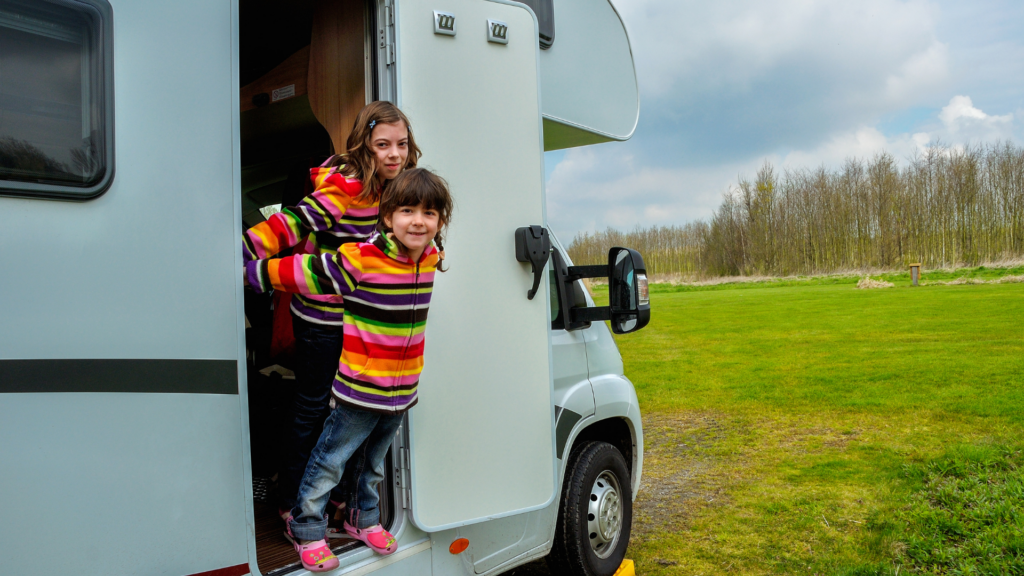Isn’t roadschooling supposed to be a free-for-all? For some families, it might be. But for the best roadschooling experience, for both parents and children, create a roadschooling schedule. This routine will help with preparations and let you adjust to obstacles. Let’s take a closer look at this homeschooling option.
What Is Roadschooling?
Many RVers choose roadschooling as opposed to homeschooling. The biggest difference is that parents use the “road” or their travel plans to dictate their children’s learning. For example, a family traveling to South Dakota might choose materials relating to the Black Hills National Forest or about the presidents on Mount Rushmore, or about animals native to that area.
On the other hand, parents who follow a more traditional homeschooling regimen will continue studying whatever material is in the curriculum they’ve chosen for that year regardless of where they’re traveling. Many parents prefer roadschooling because it’s a more organic learning approach, and their children receive hands-on learning experiences.

Who Can Practice Roadschooling?
Anyone can practice roadschooling, but parents must be aware of laws in their domicile state. Some states have more relaxed homeschooling laws and allow for deeper roadschooling education.
Other states have more strict homeschooling laws that require parents to abide by certain guidelines. New York, Pennsylvania, Vermont, Massachusetts, and Rhode Island have some of the toughest regulations, whereas Texas, Oklahoma, Michigan, New Jersey, Idaho, and some Midwest states have no regulations. Know your domicile state’s homeschooling laws. Then adapt learning to meet the criteria set forth by those regulations.
How to Create a Roadschooling Schedule
Roadschooling may happen more organically, but that doesn’t mean you don’t need preparation. You may have to plan even more because of your travel lifestyle. If you aren’t following a curriculum, it’s all on you, so you’ll want to plan based on where you’re traveling.
Plan Your Roadschooling Schedule Around Your Travel Days
Some weeks you may travel on Sunday. Other weeks you may travel on Tuesday. Plan your roadschooling schedule around your travel days so that you don’t have to mix tearing down camp and roadschooling. You might take a field trip to a botanical garden on Saturday and have a learning experience that day instead.

Know Your Local Guidelines
Just because you travel full-time doesn’t mean your children are exempt from local guidelines. Check out the HSLDA website for help on your domicile state’s regulations. You may have to turn in paperwork or keep an attendance log. Your roadschooling schedule should reflect those regulations.
Create a Plan for Each Child
If you have multiple children, don’t expect each child to learn the same way. You know your children better than anyone, so take advantage of that knowledge. Create a plan that best suits each child. You can’t expect a five-year-old to learn the same way a 15-year-old learns. Your roadschooling schedule may be 9-10 a.m. for a first grader and then 10-11:45 a.m. for an eleventh grader. Don’t force the same plan and schedule on each child. This will create frustration for everyone.
The Junior Ranger program is a great resource for roadschooling for elementary-age children. But once your child reaches pre-teen and teen years, you’ll want more in-depth study. Museums, zoos, and cultural arts centers offer a wide variety of learning experiences for children of all ages. Keep in mind the age, learning style, and ability of each child so that learning remains fun for everyone. Make sure your roadschooling schedule reflects this diversity.
Stay Consistent
It can be easy to shrug off roadschooling responsibilities in a travel lifestyle. But one of the biggest mistakes you can make as a parent is inconsistency. Make a plan for your roadschooling routine. What will you do every Monday morning? Will your school week run Monday-Friday? What time will you start school? Maintain a consistent roadschooling schedule so that your children have clear expectations.
This doesn’t mean you can’t change your routine. Perhaps one week you’re in a heavily populated area like Houston where there are numerous museums and places to visit. Instead of following your typical routine, you go into the city three days that week. Or maybe you’re visiting a huge National Park like the Grand Canyon and want to spend several days exploring the geological museum and going on hikes. This is a luxury of roadschooling. Maybe there isn’t “book learning” that day at 9 a.m., but you can still begin the school day at 9 a.m. by heading out to the Rim Trail.
Include Field Trips
As mentioned before, visiting museums, zoos, and cultural arts centers is one of the best advantages of roadschooling. These field trips offer hands-on learning that your children won’t get in a book. Take advantage of reciprocal memberships across the country. Use these field trips as opportunities for family learning and connecting with your children. Make time in your roadschooling schedule for consistent field trips.

Have a Backup Plan
As with any plan, have a plan B (and even a plan C). You might have planned an amazing hike through Acadia National Park, but it rains for three straight days. What will you do instead? Roadschooling doesn’t have to be active, hands-on learning, even though that’s certainly a perk. Can you check out a book about the history of Acadia National Park or watch a video online? Always plan for challenges.
Roadschooling Opens Doors For Learning
Roadschooling is one of the best ways for children who live and travel full-time to learn. Instead of reading about Fort Sumter, visit it! Instead of reading about the redwoods, see them! Roadschooling opens all kinds of doors for learning — for both the children and adults in your family. But it does require a roadschooling schedule. What will you learn at your next destination? And what does the best learning routine look like for your family?

Leave a Reply